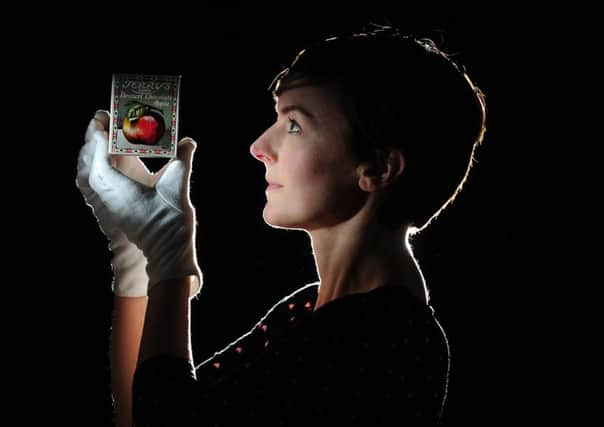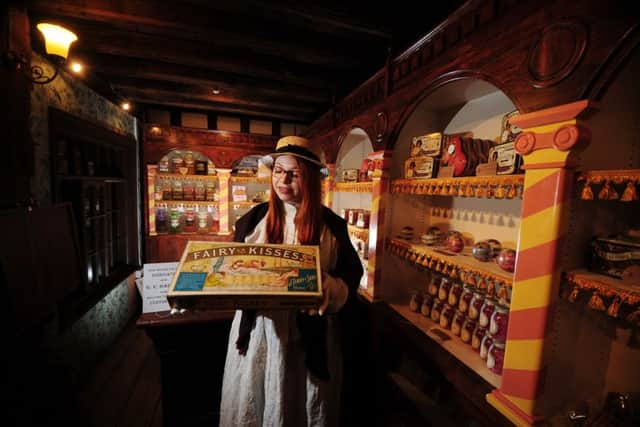Sweet little mystery


“Sex and luxury,” says food historian Dr Annie Gray. “Those two words have always been associated with chocolate and I suspect they always will be. We all have a need for a guilty pleasure or two and ever since chocolate arrived on these shores that’s what it has been.”
She’s right. From the lavishly decorated boxes of the Victorian period to the Black Magic seduction of the 1980s and that Flake advert, indulgence and chocolate have always been closely linked. Its status as a culinary vice, along with our relationship with sugar, spice and all things nice, will be explored in an exhibition at York Castle Museum which opens today.
Advertisement
Hide AdAdvertisement
Hide AdChocolate: York’s Sweet Past is a new trail which runs through all of the museum’s period rooms as well as the historic Kirkgate shopping street. Giving a nod to some of the city’s most famous names, including one of the city’s original chocolatiers, Mary Tuke, and the two Josephs – Rowntree and Terry – it also looks at how the dark stuff went from being a rich man’s treat to an affordable tuck shop favourite.


“Visitors experience the rooms in reverse chronological order, so what we have created is hopefully a journey back in time,” says curator Katie Brown, who has had the task of going through the museum’s extensive confectionary collections to pull together items for the exhibition. “As soon as they walk in they will see display cases featuring a variety of chocolate brands from down the decades, some of which they will recognise and some which never really made it.
“While the Terry’s Chocolate Orange is one of the most popular brands today, we’ve also got examples of the original Chocolate Apple, as well as the Chocolate Lemon and the Chocolate Raspberry which never did as well.
“Everyone has a bar of chocolate or a particular sweet which reminds them of their childhood, but as well as being an opportunity to wallow in a little nostalgia, the trail will hopefully show how our tastes have been shaped and changed over the centuries.”
Advertisement
Hide AdAdvertisement
Hide AdThe story of our love affair with all things sweet really begins in the 17th century when both sugar and chocolate found their way across the thousand of miles of ocean from the plantations of Central America and the Caribbean.


“In the early years it was very much a rich person’s drink,” says Dr Gray, who will be hosting an event at the museum in the summer in praise of what she calls the “divine bean”. “It had filtered up through Europe and was brought to Britain by a succession of sea captains. It was incredibly expensive, but the very wealthy soon developed a taste for it.
“It’s funny really, while tea was something associated with women and coffee was very much the drink of the businessman, chocolate, which was initially turned into a drink rather than something that was eaten, was always associated with luxury and high-end tastes.
“However, the hot chocolate of back then was very different to the drink we have become used to. In the early years, it had quite a high fat content and while it didn’t taste fatty, it was quite gritty. It might not sound very appetising, but it quickly became popular and there were various entrepreneurs who knew that if they could find a way to take it mainstream they could make an awful lot of money.”
Advertisement
Hide AdAdvertisement
Hide AdOne of them was the 19th century Swiss chocolatier Rodolphe Lindt. Already the head of a successful confectionery business, his fortunes grew even further when he accidentally left one of his chocolate-mixing machines on overnight. Returning to his workshop the following morning, he found the continuously turned chocolate was far smoother than any he had come across before. A new technique known as conching was born.
“Milk chocolate wasn’t invented until the 19th century and it wasn’t until 1857 that Fry and Son invented the first ever chocolate bar,” says Katie. “An early advert in our collection shows that in the 17th century chocolate was selling for between three and 10 shillings a pound, which is the equivalent of between £300 and £1,000 in today’s money. Even 100 years later, the cost was still prohibitive for many people and sweets, which were significantly cheaper, remained much more popular.”
Sugared almonds, which had come over from France, were big sellers and the Victorians also developed a range of novelty confectionary called conversation sweets. The forerunners of modern- day Love Hearts, they were made of sugar paste with mottos stamped on them.
Some, like “Can you polka?” and “You make me blush”, were mildly flirtatious. Others were more direct, with “I want a wife” really cutting to the chase and a few were designed to suck the joy out of indulgence, noting that “Temperance in the surest road to wealth”.
Advertisement
Hide AdAdvertisement
Hide Ad“York has such a rich connection to the history of chocolate and sweet-making and its social impact was something that we really wanted to explore,” adds Katie. “Much of the story is told through our existing collections, but we have also taken delivery of our very own sweet-making machine, which will add a Willy Wonka element to the exhibition.”
Elsewhere there will be a chance to explore what it was really like to work in one of York’s major factories when chocolate-making was in its heyday, and throughout the nine-month exhibition there will also be a programme of talks, tastings and workshops.
“The food people ate tells us a lot about the society they lived in,” says Dr Gray, whose new book, The Greedy Queen, a culinary biography of Queen Victoria, is out next month. “In the early 19th century, a revolution took place in how we ate, from the highest table in the land to the most humble, and I wanted to explore that through the life of Victoria. The image we have of her tends to be later in life when she had become rather large through belligerent over-eating, but actually in her youth she pretty much lived on bread and milk.
“Her mother devised what was known as the Kensington System, which was basically aimed at rendering the young Princess Victoria weak and dependent. Her every waking hour was controlled and so was her food. Perhaps unsurprisingly, it ended up backfiring and when she was old enough Victoria rebelled against her past life.
Advertisement
Hide AdAdvertisement
Hide Ad“Her reign is a really interesting way to look at how Britain’s relationship with food changed. It went from being something that was functional to something which was to be enjoyed and savoured and the arrival of chocolate was key to that change.”
York’s Sweet Past runs at the Castle Museum until the end of the year. On July 10, Dr Annie Gray will host In Due Praise of Chocolate: Drinking, eating and cooking the divine bean in Georgian England. Tickets cost £8 and to book go to yorkcastlemuseum.org.uk